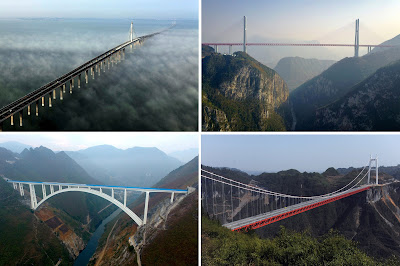Too Short for a Blog Post, Too Long for a Tweet LXXV
 Here's an excerpt from a New York Times article I just read, "China’s New Bridges: Rising High, but Buried in Debt":
Here's an excerpt from a New York Times article I just read, "China’s New Bridges: Rising High, but Buried in Debt":
“The
amount of high bridge construction in China is just insane,” said Eric
Sakowski, an American bridge enthusiast who runs a website on the world’s highest bridges. “China’s opening, say, 50 high bridges a year, and the whole of the rest of the world combined might be opening 10.”
Of
the world’s 100 highest bridges, 81 are in China, including some
unfinished ones, according to Mr. Sakowski’s data. (The Chishi Bridge
ranks 162nd.)
China also has the world’s longest bridge, the 102-mile Danyang-Kunshan Grand Bridge,
a high-speed rail viaduct running parallel to the Yangtze River, and is
nearing completion of the world’s longest sea bridge, a 14-mile
cable-stay bridge skimming across the Pearl River Delta, part of a
22-mile bridge and tunnel crossing that connects Hong Kong and Macau with mainland China.
The
country’s expressway growth has been compared to that of the United
States in the 1950s, when the Interstate System of highways got
underway, but China is building at a remarkable clip. In 2016 alone,
China added 26,100 bridges on roads, including 363 “extra large” ones
with an average length of about a mile, government figures show.
China
also devotes a much higher share of its economy to building
infrastructure than the West — about 9 percent versus about 2.5 percent
in the United States and Western Europe, according to the McKinsey Global Institute.
A
primary motive is economic growth: Infrastructure spending surged as
part of a huge stimulus program after the 2008 global financial crisis.
Each bridge can cost billions and employ hundreds of workers for several
years.
But the endless construction has also created a self-perpetuating gravy train, feeding corruption and distorting priorities.

Comments